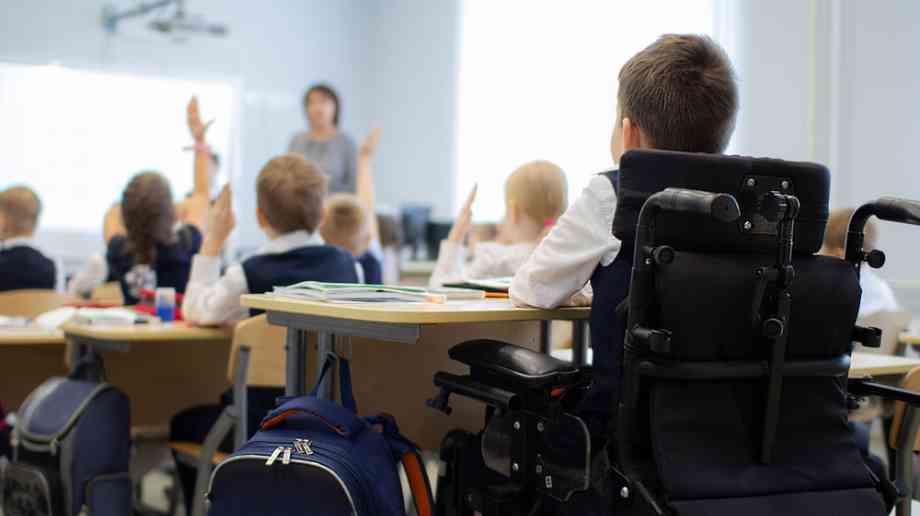
Tackling disability discrimination in schools
Understanding the experiences of disabled children and making appropriate adjustments can make a significant difference to their time in school and their ability to learn, writes Caroline Withers, trustee director at Support SEND Kids
“Teaching: Every Lesson Shapes a Life”, says a recent Department for Education advertising campaign to inspire more people to sign up to teach. Educational professionals do of course play an unparalleled role in shaping the lives of the young people they teach – it’s both a cliche, and a truism that “we all remember a good teacher” (shout out to Mrs Lewis from me!).
School plays a fundamental and formative part in every child’s life. It’s a place where we learn not just reading, writing and arithmetic, but key social skills and our first independent experience of the world outside the home.
Yet consider “Diversity, Equity and Inclusion”. More than just being the buzzwords of the moment, these words encapsulate fundamental rights that recognise the inherent value that each human being, child or adult, has, and their need to “belong”, and be included in education, the workplace and society. No decent person would deny this. Yet inequality persists in society and marginalised groups continue to exist. Whose job is it to change this? How can we really make a difference? The answer to this big question is, like the answer to most things: education, education, education.
I’ll stop with the taglines and buzzwords... We all own the ability to understand more about the lived experiences of the people whose lives we impact upon, and so much weight and responsibility is placed on frontline teaching staff to support all of the children in their care. Yet, for pupils with Special Educational Needs and Disabilities (SEND), only the most basic policies and practices are put into place to ensure equal access to learning: a rudimentary framework focused on bare minimum compliance with law and regulation. We are some way off from an education system that works for everyone.
The barriers in society and education
The Social Model of Disability teaches us that people are disabled by barriers in society, not by their “impairment” or difference. These barriers can be physical, like buildings not being accessible: stairs instead of ramps, or no accessible toilets; they can be caused by people’s attitudes to difference: stigma, unhelpful stereotypes and assumptions that people with disabilities can’t be independent; or by widely accepted practices: discrimination, segregated education, or lack of opportunities. The Social Model helps us recognise that barriers make life harder for people with disabilities, and removing these barriers is what creates equality.
No child should have to face barriers to education and learning, both of which we all accept are fundamental to opportunities in life. Improvements have been made in recognising some elements of different learning styles and needs for people with disabilities, however, we must all appreciate the reality of a society and an education system that is simply not built with people with disabilities in mind. A child who is not supported to access education will not be in a position to thrive. In fact, the only lesson they will learn is that they are not accepted by society. They don’t “fit in”. There’s “something wrong” with them. They are seen to have less value. It’s a sad truth that in more areas than we realise, our system is failing the most vulnerable and we are traumatising disabled children at the earliest of ages.
The need for change
We all want to change the world for the children we parent, teach or support for the better. The first step we must all take is recognising and addressing discriminatory practices. That includes combating our own prejudices having grown up in a society and having been educated in a system that has conditioned us to make certain assumptions.
The next step is to take positive action to ensure inclusion – often even small measures or adjustments to avoid the specific difficulties a person may experience because of their disabilities can make a significant difference.
I am a lawyer and a mother to a disabled child. My husband is a qualified teacher and a university lecturer. We are still on a learning journey ourselves in all of these things, not least when getting to grips with the ordeal of the legal process associated with securing the appropriate educational support for my disabled daughter via the issuance of an “EHCP”, or Education and Health Care Plan, by my local authority. Despite being a highly experienced lawyer myself, and no stranger to dealing with an adversarial process, I was overwhelmed and incredulous at the system I found myself trying to navigate.
From my community of fellow parents of children with disabilities, I have heard some truly heart-breaking stories: a two year old child being excluded from nursery because he has epilepsy and his seizures are “stressing out” the staff; another family being refused a place at more than five separate nurseries once those establishments learned their child was disabled; a child with sensory processing disorder who was punished by teachers for not wearing their itchy school jumper by being forced to spend breaktime alone in a classroom; a child who is a wheelchair user being excluded from a school trip to an adventure playground because there is no access or facilities for them to participate.
On the flipside, I’ve also heard of wonderful stories of teachers willing to think outside the box and do things differently to support disabled children. For example, a teacher who noticed a child with epilepsy was missing significant time in school due to his seizures made time to call in on the child in their home setting to ensure when he returns he has a familiar adult to welcome him. How can we shift the balance so that the positive experiences outweigh the traumatic ones?
Knowledge is power – but is it enough?
I wholeheartedly believe in access to justice for all families of disabled children. One of the biggest challenges parents face is understanding what their legal position is and what their options are. Thankfully, there are a host of charities active in this space offering a mix of practical information and emotional support to families. However, arming families with information about how they can advocate for their children’s rights is not a complete solution and does not go to the heart of the problem. By the time a parent or carer finds themselves in the position of seeking advice on the law, their child has often already been let down by the system.
The fact is this: a child’s experience of education is largely determined by the setting that they attend, the culture of that establishment, and the ability of educational professionals to enable them to access the learning there in a positive way. What we need is a system that takes as its starting point a more collaborative, rather than adversarial, relationship between local authorities and parents of children with disabilities, so that parents no longer need to grapple with a lengthy and costly tribunal system to secure the additional support their child needs, as I and thousands of other parents have had to do.
The long-awaited SEND review is now out, and while it has some good measures, many believe it does not go far enough to fix the SEND system.
Bringing schools, local authorities and parents together
I joined Support SEND Kids as a trustee director in 2021. We are a charity and bespoke legal technology platform that presents complicated, technical legal information in a user friendly, Q&A format, accessible to SEND families, legal and educational professionals, and local authorities. The aim is to bring the critical parts of the community together with direct and free access to lawyers and other SEND specialists who are a scarce resource in this space.
Our most recent achievement is the launch of a new digital guide for SEND families on disability discrimination in education authored by Mandy Aulak and Sean Kennedy of Talem Law. It is a free public resource to assist all those who deal with special educational needs and disability law – including judges, legal practitioners, local authorities, educational professionals and parents. The guide is designed to help all those who support children with a disability start to understand how the law around disability discrimination works in education so that they can request the additional disability related support that their children are legally entitled to.
The aim is to democratise access to a more complete and accurate picture of a child’s legal position, empowering all those who support children’s access to education – be they families, schools, local authorities or the tribunal system.
No one person can change a whole system, but armed with knowledge of disabled children’s experience, we can work together to identify those adjustments that can make the most difference to their time in school and their ability to learn. When schools, local authorities and parents work together, we really do have the ability to shape and transform the lives of these children.
Latest News
07/11/2025 - 09:54
The Scottish Government has announced funding which will go to local councils for strategic approaches to closing the poverty-related attainment gap.
06/11/2025 - 09:42
Ofsted has shared findings from pilot inspections carried out in 115 schools this autumn, ahead of the full rollout of its renewed inspection framework.
06/11/2025 - 09:16
The TV, radio and multi media campaign deals with the root causes of absences and identifies ways to approach conversations about wellbeing that can help pupils to improve their attendance.
05/11/2025 - 09:49
The government will publish a new set of enrichment benchmarks, with schools asked to ensure every child has access to activities across five categories of enrichment.
05/11/2025 - 09:37
For the first time, primary aged children will gain vital skills like how to spot fake news and identify misinformation and disinformation.







